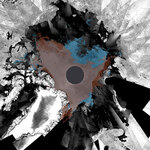Oceanography
What images do the words 'traumatic fertilization' conjur? If you are picturing deep-sea squid, you are either a fellow subscriber to Scientific American's daily digest or in dire need of pscyhological help.
This little nugget of 'size does matter' wisdom popped into my email inbox today, and I have to share.
Gary Stix (no discernable relation to the rock band Styx) started the story with this little gem: "What do you do to pass on your genes to the next generation if you are really hard up, it’s too dark to see clearly and you are literally under enormous pressure. The short…

In the search for life beyond Earth, scientists 'follow the water' to find places that might be hospitable. However, every home gardener knows that plants need more than water, or even sunshine. They also need fertilizer – a mixture of chemical elements that are the building blocks of the molecules of life. Scientists at Arizona State University are studying how the distribution of these elements on Earth – or beyond – shapes the distribution of life, the state of the environment and the course of evolution.
Ariel Anbar, a professor in ASU's Department of Chemistry and Biochemistry and the…

pH is a very sensitive thing, and anyone who's ever had a fish tank knows this delicate cycle of acids and bases. When water becomes either too acidic or basic, marine organisms cannot handle the change, but if pH levels change loosely over a span of time, organisms are usually able to adapt. The only problem with that is current research showing ocean acidity growing 10x faster than predicted, signaling a massive potential problem.
The study on oceanic pH change titled "Dynamical Patterns and Ecological Impacts of Declining Ocean pH in a High-Resolution Multi-Year Dataset," was…

Observations from satellites now allow scientists to monitor changes to water levels in the sea, in rivers and lakes, in ice sheets and even under the ground. As the climate changes, this information will be crucial for monitoring its effects and predicting future impacts in different regions.
Sea level rise in one of the major consequences of global warming, but it is much more difficult to model and predict than temperature. It involves the oceans and their interaction with the atmosphere, the ice sheets, the land waters and even the solid Earth, which modifies the shapes of ocean basins.…

The thickness of sea ice in large parts of the Arctic declined by as much as 19% last winter compared to the previous five winters, according to data from ESA's Envisat satellite.
Using Envisat radar altimeter data, scientists from the Centre for Polar Observation and Modelling at University College London (UCL) measured sea ice thickness over the Arctic from 2002 to 2008 and found that it had been fairly constant until the record loss of ice in the summer of 2007. Unusually warm weather conditions were present over the Arctic in 2007, which some scientists have said explain that summer ice…

Last winter, the thickness of sea ice in large parts of the Arctic fell by nearly half a metre (19 per cent) compared with the average thickness of the previous five winters. This followed the dramatic 2007 summer low when Arctic ice extent dropped to its lowest level since records began.
Up until last winter, the thickness of Arctic sea ice showed a slow downward trend during the previous five winters, but after the summer 2007 record low extent, the thickness of the ice also nose-dived. What is concerning is that sea ice is not just receding but it is also thinning.
Some…

As more and more greenhouse gases are released into the atmosphere and the oceans warm, their chemistry also changes — seawater becomes more acidic as carbon dioxide from the atmosphere dissolves.
According to a paper to be published this week by marine chemists at the Monterey Bay Aquarium Research Institute, these changes in ocean temperature and chemistry will have an unexpected side effect— sounds will travel farther underwater.
This illustration shows how increasing carbon dioxide in the atmosphere leads to an increase in the acidity of seawater, which in turn allows sounds (such as…

The rise in atmospheric CO2 levels has been a talked-about subject for quite some time, but while scientists and politicians are coming to what they call a “solution,” the impact on marine environments is being ignored.
Proposed emission cuts are aiming to significantly lower the amount of CO2 produced within the United States, but what impact does this value have outside the human world? Scientists say that even the lowest proposed percentages aren’t nearly enough to halt oceanic damage.
CO2 is a soluble gas that is easily absorbed into the ocean’s waters. When CO2 is combined with…

Observations of ice coverage in the Arctic from space began 30 years ago so it's inflammatory to talk about record lows in such a short period of time but two consecutive years near this 'record' still merit some concern.
Because the extent of ice cover is usually at its lowest about mid-September, this year's minimum could still fall and set another record low.
Envisat observations from mid-August depict that a new record of low sea-ice coverage could be reached in a matter of weeks. The animation above is a series of mosaics of the Arctic Ocean created from images acquired between early…

It was two years ago that I first wrote about ocean dead zones. These are areas of the ocean that, due to a lack of oxygen, no longer sustain any life. While dead zones can happen naturally, they usually are caused by the results of human activity. A primary cause is nitrogen-rich nutrients from agricultural fertilizers that flow into coastal waters from rivers and streams.
Last week there was a report published in the Journal of Science that stated that the number of these ocean dead zones around the world has doubled every decade since the 1960s. There are now some 400…